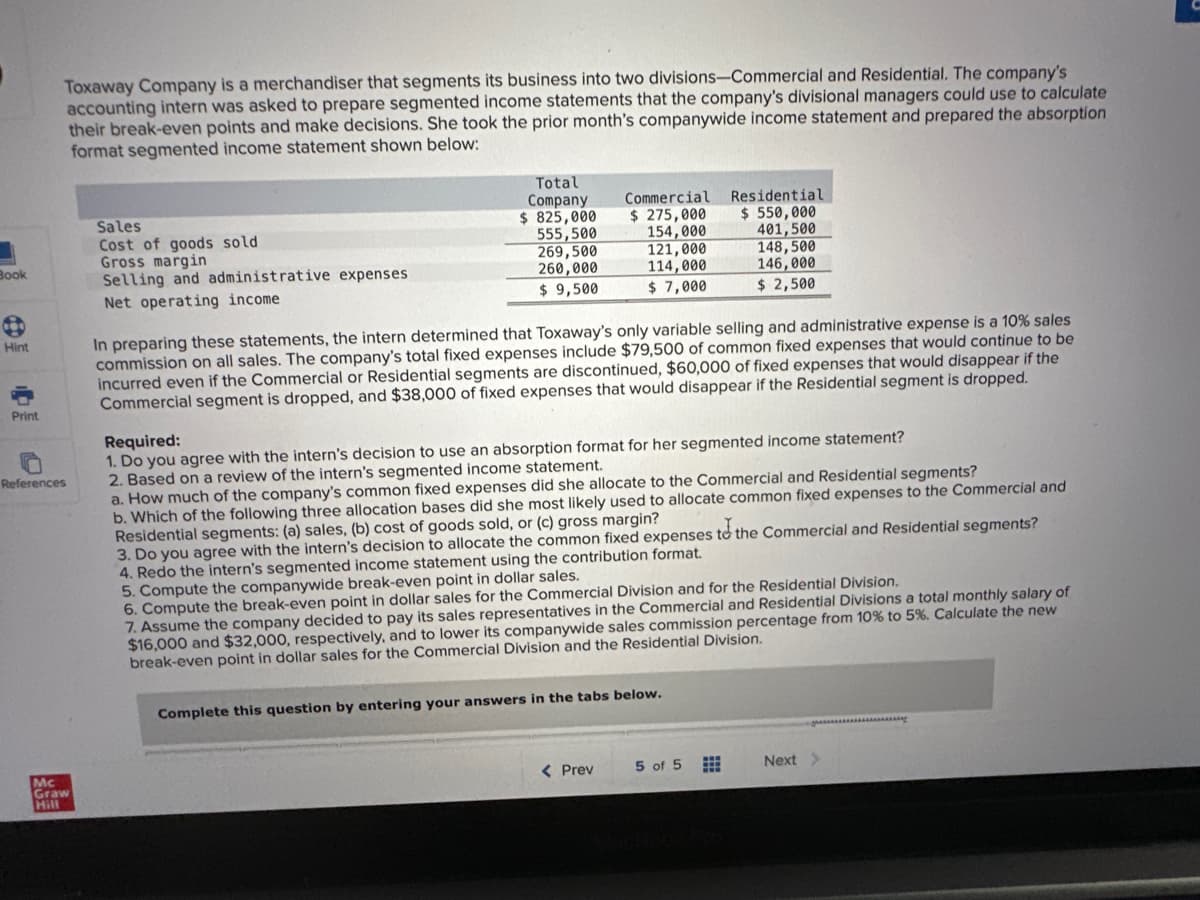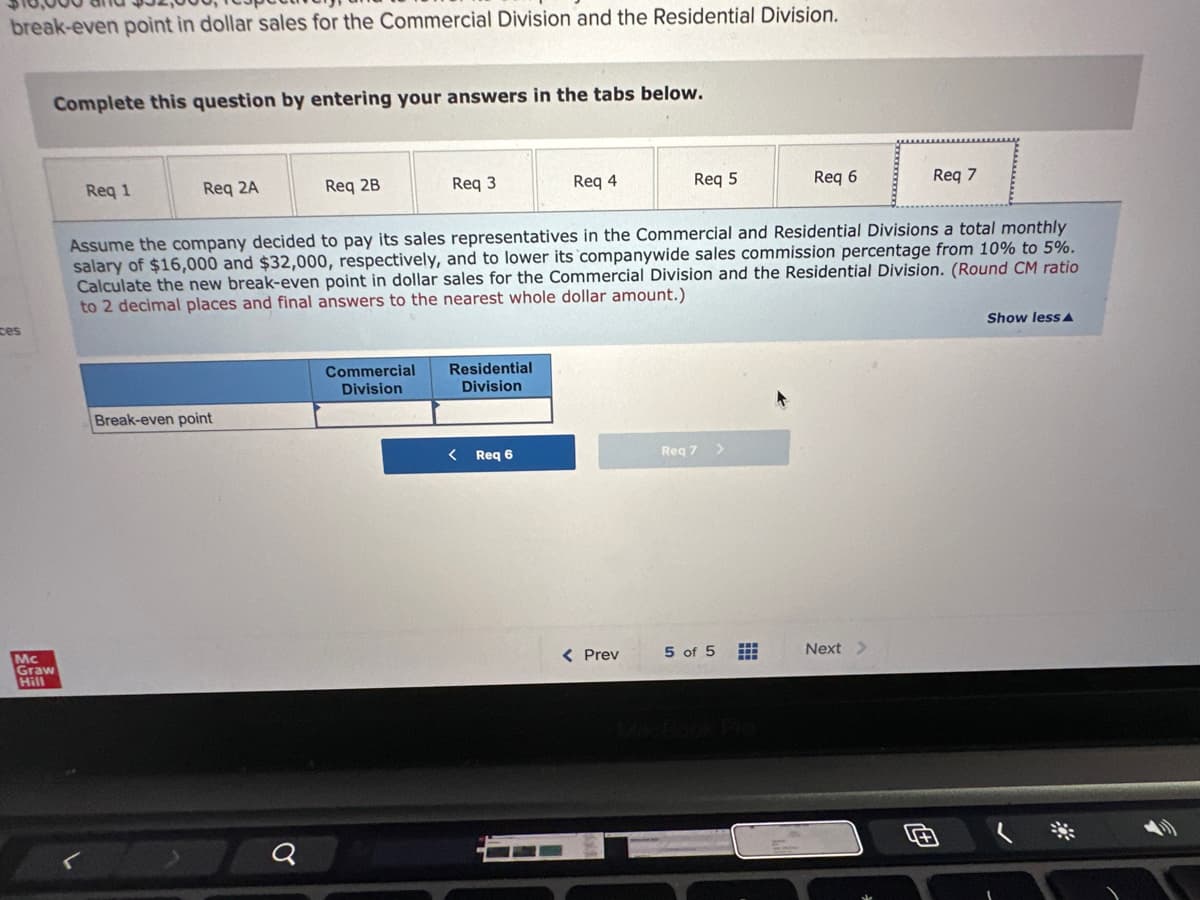Toxaway Company is a merchandiser that segments its business into two divisions-Commercial and Residential. The company's accounting intern was asked to prepare segmented income statements that the company's divisional managers could use to calculate their break-even points and make decisions. She took the prior month's companywide income statement and prepared the absorption format segmented income statement shown below: nces Sales Cost of goods sold Gross margin Selling and administrative expenses Net operating income Total Company $ 825,000 555,500 269,500 260,000 $ 9,500 Commercial Residential $ 550,000 $ 275,000 154,000 121,000 401,500 148,500 146,000 114,000 $7,000 $ 2,500 In preparing these statements, the intern determined that Toxaway's only variable selling and administrative expense is a 10% sales commission on all sales. The company's total fixed expenses include $79,500 of common fixed expenses that would continue to be incurred even if the Commercial or Residential segments are discontinued, $60,000 of fixed expenses that would disappear if the Commercial segment is dropped, and $38,000 of fixed expenses that would disappear if the Residential segment is dropped. Required: 1. Do you agree with the intern's decision to use an absorption format for her segmented income statement? 2. Based on a review of the intern's segmented income statement. a. How much of the company's common fixed expenses did she allocate to the Commercial and Residential segments? b. Which of the following three allocation bases did she most likely used to allocate common fixed expenses to the Commercial and Residential segments: (a) sales, (b) cost of goods sold, or (c) gross margin? 3. Do you agree with the intern's decision to allocate the common fixed expenses to the Commercial and Residential segments? 4. Redo the intern's segmented income statement using the contribution format. 5. Compute the companywide break-even point in dollar sales. 6. Compute the break-even point in dollar sales for the Commercial Division and for the Residential Division. 7. Assume the company decided to pay its sales representatives in the Commercial and Residential Divisions a total monthly salary of $16,000 and $32,000, respectively, and to lower its companywide sales commission percentage from 10% to 5%. Calculate the new break-even point in dollar sales for the Commercial Division and the Residential Division.
Toxaway Company is a merchandiser that segments its business into two divisions-Commercial and Residential. The company's accounting intern was asked to prepare segmented income statements that the company's divisional managers could use to calculate their break-even points and make decisions. She took the prior month's companywide income statement and prepared the absorption format segmented income statement shown below: nces Sales Cost of goods sold Gross margin Selling and administrative expenses Net operating income Total Company $ 825,000 555,500 269,500 260,000 $ 9,500 Commercial Residential $ 550,000 $ 275,000 154,000 121,000 401,500 148,500 146,000 114,000 $7,000 $ 2,500 In preparing these statements, the intern determined that Toxaway's only variable selling and administrative expense is a 10% sales commission on all sales. The company's total fixed expenses include $79,500 of common fixed expenses that would continue to be incurred even if the Commercial or Residential segments are discontinued, $60,000 of fixed expenses that would disappear if the Commercial segment is dropped, and $38,000 of fixed expenses that would disappear if the Residential segment is dropped. Required: 1. Do you agree with the intern's decision to use an absorption format for her segmented income statement? 2. Based on a review of the intern's segmented income statement. a. How much of the company's common fixed expenses did she allocate to the Commercial and Residential segments? b. Which of the following three allocation bases did she most likely used to allocate common fixed expenses to the Commercial and Residential segments: (a) sales, (b) cost of goods sold, or (c) gross margin? 3. Do you agree with the intern's decision to allocate the common fixed expenses to the Commercial and Residential segments? 4. Redo the intern's segmented income statement using the contribution format. 5. Compute the companywide break-even point in dollar sales. 6. Compute the break-even point in dollar sales for the Commercial Division and for the Residential Division. 7. Assume the company decided to pay its sales representatives in the Commercial and Residential Divisions a total monthly salary of $16,000 and $32,000, respectively, and to lower its companywide sales commission percentage from 10% to 5%. Calculate the new break-even point in dollar sales for the Commercial Division and the Residential Division.
Managerial Accounting
15th Edition
ISBN:9781337912020
Author:Carl Warren, Ph.d. Cma William B. Tayler
Publisher:Carl Warren, Ph.d. Cma William B. Tayler
Chapter4: Activity-based Costing
Section: Chapter Questions
Problem 18E
Related questions
Question

Transcribed Image Text:Book
B
Hint
Print
Toxaway Company is a merchandiser that segments its business into two divisions-Commercial and Residential. The company's
accounting intern was asked to prepare segmented income statements that the company's divisional managers could use to calculate
their break-even points and make decisions. She took the prior month's companywide income statement and prepared the absorption
format segmented income statement shown below:
References
Mc
Graw
Hill
Sales
Cost of goods sold
Gross margin
Selling and administrative expenses
Net operating income
Total
Company
$ 825,000
555,500
269,500
260,000
$ 9,500
Commercial Residential
$275,000 $ 550,000
154,000
401,500
148,500
146,000
$ 2,500
121,000
114,000
$ 7,000
In preparing these statements, the intern determined that Toxaway's only variable selling and administrative expense is a 10% sales
commission on all sales. The company's total fixed expenses include $79,500 of common fixed expenses that would continue to be
incurred even if the Commercial or Residential segments are discontinued, $60,000 of fixed expenses that would disappear if the
Commercial segment is dropped, and $38,000 of fixed expenses that would disappear if the Residential segment is dropped.
Required:
1. Do you agree with the intern's decision to use an absorption format for her segmented income statement?
2. Based on a review of the intern's segmented income statement.
a. How much of the company's common fixed expenses did she allocate to the Commercial and Residential segments?
b. Which of the following three allocation bases did she most likely used to allocate common fixed expenses to the Commercial and
Residential segments: (a) sales, (b) cost of goods sold, or (c) gross margin?
3. Do you agree with the intern's decision to allocate the common fixed expenses to the Commercial and Residential segments?
4. Redo the intern's segmented income statement using the contribution format.
5. Compute the companywide break-even point in dollar sales.
6. Compute the break-even point in dollar sales for the Commercial Division and for the Residential Division.
7. Assume the company decided to pay its sales representatives in the Commercial and Residential Divisions a total monthly salary of
$16,000 and $32,000, respectively, and to lower its companywide sales commission percentage from 10% to 5%. Calculate the new
break-even point in dollar sales for the Commercial Division and the Residential Division.
< Prev
Complete this question by entering your answers in the tabs below.
5 of 5
Next >

Transcribed Image Text:break-even point in dollar sales for the Commercial Division and the Residential Division.
ces
Complete this question by entering your answers in the tabs below.
Mc
Graw
Hill
Req 1
Req 2A
Break-even point
Req 2B
Q
Req 3
Commercial
Division
Assume the company decided to pay its sales representatives in the Commercial and Residential Divisions a total monthly
salary of $16,000 and $32,000, respectively, and to lower its companywide sales commission percentage from 10% to 5%.
Calculate the new break-even point in dollar sales for the Commercial Division and the Residential Division. (Round CM ratio
to 2 decimal places and final answers to the nearest whole dollar amount.)
Residential
Division
<
Req 4
Req 6
Req 5
< Prev
Req 7
5 of 5
>
Req 6
#
Req 7
Next >
Ⓒ
Show less A
Expert Solution
This question has been solved!
Explore an expertly crafted, step-by-step solution for a thorough understanding of key concepts.
This is a popular solution!
Trending now
This is a popular solution!
Step by step
Solved in 5 steps

Knowledge Booster
Learn more about
Need a deep-dive on the concept behind this application? Look no further. Learn more about this topic, accounting and related others by exploring similar questions and additional content below.Recommended textbooks for you

Managerial Accounting
Accounting
ISBN:
9781337912020
Author:
Carl Warren, Ph.d. Cma William B. Tayler
Publisher:
South-Western College Pub

Financial And Managerial Accounting
Accounting
ISBN:
9781337902663
Author:
WARREN, Carl S.
Publisher:
Cengage Learning,

Managerial Accounting: The Cornerstone of Busines…
Accounting
ISBN:
9781337115773
Author:
Maryanne M. Mowen, Don R. Hansen, Dan L. Heitger
Publisher:
Cengage Learning

Managerial Accounting
Accounting
ISBN:
9781337912020
Author:
Carl Warren, Ph.d. Cma William B. Tayler
Publisher:
South-Western College Pub

Financial And Managerial Accounting
Accounting
ISBN:
9781337902663
Author:
WARREN, Carl S.
Publisher:
Cengage Learning,

Managerial Accounting: The Cornerstone of Busines…
Accounting
ISBN:
9781337115773
Author:
Maryanne M. Mowen, Don R. Hansen, Dan L. Heitger
Publisher:
Cengage Learning

Principles of Accounting Volume 2
Accounting
ISBN:
9781947172609
Author:
OpenStax
Publisher:
OpenStax College

Cornerstones of Cost Management (Cornerstones Ser…
Accounting
ISBN:
9781305970663
Author:
Don R. Hansen, Maryanne M. Mowen
Publisher:
Cengage Learning

Essentials of Business Analytics (MindTap Course …
Statistics
ISBN:
9781305627734
Author:
Jeffrey D. Camm, James J. Cochran, Michael J. Fry, Jeffrey W. Ohlmann, David R. Anderson
Publisher:
Cengage Learning